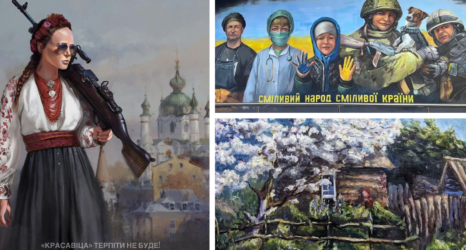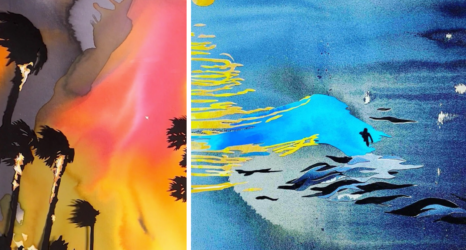Ivette Cabrera is a Miami-based artist who strives to break the barriers society has presented upon women, especially women of color, through her artwork. Cabrera lets her art do the talking when it comes to the stance of woman all over the world.
Cabrera took some time to chat with Ms. about her take on women’s empowerment, art, beauty, identity and gender roles.
What inspired you to draw crowns on women?
My intention is to portray women from different cultural backgrounds embracing their own inner power and strength. Every woman is born wearing a crown because the crown is a symbol of power. The beauty is found in the crown, because it is a representation of my own skill as an artist. Society often has preset barriers and roles that are placed upon women, especially those from certain backgrounds. My work is an attempt to highlight and then break down those barriers so that any woman can see herself as potent and influential, like the women in my art.
…I originally came across the concept to draw powerful women because of my history as an immigrant in the country. I started to dig back into the Sandinista revolutions in my country Nicaragua and came across a very powerful image of a woman holding a rifle while breastfeeding a baby. It made me realize that women are not only mothers but they are also warriors fighting for a just cause. I started to dig into some of the history of women and various other cultures worldwide. I found that many cultures often upheld women, some restricted them, some worshiped them and some oppressed them. I felt it was necessary to begin to help tell the story so women can establish their own sense of identity with themselves.
How would you define and describe your art? Do you think it reflects feminism?
My art is about allowing women to see themselves as powerful. As an artist, I am only a story teller hoping that the story of all women is documented, because one day I will also cease to exist and the memories of our power may be forgotten.
I originally studied Interior Architecture and Design so my art has a major influence from that field. I began to teach myself art four years ago and I have refined my skills and craft so the message is not lost in bad art. I feel that too many artists out there are making child-like art and it gets sold for lots of money. As a society we should move away from this to show our own refinement and skill, not only because are we capable of it, but because art should be a reflection of our mental awareness and intelligence. The designs in my work reflect symmetry, balance and repetitious patterns and are a reflection of various architectural structures and architect sketches. I also use a magnifying glass to get some of the intricate details in the work.
In a way my art reflects a form of feminism that exists within all women—and that is to find what is truth to her and what makes her strong. Feminism has many meanings for others however, some fight for equality and other reproductive rights. I fight for restoring the balance that nature intended for us all. A woman cannot exist without the support and involvement of a man because they are both creators in this world. We are vital to one another and I believe that sometimes the message of what it means to be a feminist can be misinterpreted by many. A woman should be aware of what makes her unique from her male counterpart and have mutual understanding that we all rely on one another for survival but our own uniqueness should always be valued and respected. Nothing can take away the power we all have when we unite for a cause and try to understand each other.
Why do you think it’s important to shed light on the roles of different women within various societies worldwide?
I believe that when we embrace other cultures we find a piece of ourselves reflected back to us. The roles women play tell us a lot about ourselves and how we have adapted over time. It can also tell us about the economic and sociopolitical power that can control and threaten the very fabric that is humanity and community. As women today, if we don’t learn about other women and their struggles we neglect a very important piece of history that relates to our own experience. This can have some implications when trying to find your own voice within your society and many people can misjudge your actions or message if there isn’t a global awareness. So I find it crucial to celebrate the things that make women unique across the world but it’s equally important to shine light on the things that have made women restricted to share their uniqueness and talents. How have their roles within their societies limited their capabilities and development? Within our own country we find the traces of oppression from the first colonizers that landed, where long held traditions were broken and women were made to be slaves and raped. We lost a long history of what our structures and civilizations would have looked like, had the oppressors not implemented their laws that restricted development for many women and people of color. So as women and artists, we are left with a duty to share their stories and document what we can about many cultures before they are wiped out from existence.
Why do you think women should question their identity?
I believe that there’s a common misconception among women that we are preset into specific roles in our society either by being a mother, a wife, weak or submissive. Our identity and perceptions on ourselves are formed by our environment, our society and the particular time we are born into. When we reflect on our identities within our society and ask what roles does the society want us to play we come closer to understanding what is expected of us not just as a woman but as a civilization and as a people. The sad fact is that we have been conditioned by centuries of oppression that has created an off-balance in the vital roles both sexes play within society. It’s important so that we move forward together in equality and equal opportunity for all not just women.
What’s your take on beauty? How would you define it and why do you think it’s important for women to recognize it?
Beauty is the perfection of skill. What we have come to understand as beauty, can have different meanings both sociologically and physical. Our ideas of beauty are often constructed by our own society. Many women have felt the need to live up to standards placed upon them, but real beauty is not physical it’s a projection of our own creative capabilities. We live in a place that bombards us with beauty standards about our appearance. We are marketed to buy the makeup to cover us up, surgeries to make us different than we are, clothes that make us look sexy and the almost every artificial element we can apply to ourselves from fakes nails and lashes to fake hair and hair dye. Girls are marketed to see themselves as barbies, housewives, mothers, and everything’s pink.
Who makes up these standards and how much do they profit off the way women identify themselves?
Every company is seeking to attach their brand to the very concept of what being a “beautiful woman” or “powerful woman” means, but as women we have to be self-ware of how that impacts the choices we make, the things we buy and how that makes us feel about ourselves.
Should we see ourselves as beautiful or should we see ourselves as creatives, intellectuals and warriors? I feel it’s more important for women to define what makes them unique and skillful, not what makes them beautiful. When we focus our efforts on our own skills and development, we hold the power to define our own standards of beauty and not only what makes us physically beautiful.
You began an art collective and artist residency in Wynwood in 2012 called Viophilia. Can you tell me more about this and what made you want to start it?
The concept of Viophilia is a creative hive for individuals seeking art studio spaces in Miami’s thriving art district. Originally, the idea was brought about with three of my friends as a place for artist women to have studio spaces to create art. The name was made up but we defined it as an obsession with creativity. We found a 2,200 square feet warehouse located in Wynwood, Miami and put up some of the walls ourselves with the help of friends. We encourage residents to push the bounds of their potential and provided a residency program designed for artists looking to focus intensely on their craft, continue works in progress and break new ground. As Viophilia grew it made a name for itself with more and more artists wanting to join the residency. During our time at Viophilia we curated many art exhibits, art installations and events. My current partner Amir Shakir helped move Viophilia into the next stages and we held many Art Basel competitions at the space. We are currently seeking to expand Viophilia and make it bigger than before with adequate funding and resources for artists.
What artists inspire you and why?
Many artists and architects have inspired me and my artwork.
Frank Lloyd Wright for his linear and stretched out lines and because he was a major proponent in defining his church as nature. His beliefs were deeply rooted in using nature to inspire art. Zaha Hadid, an Iraqi born female architect whose fluid lines and organic forms inspire some of the lines in my work. The Art Nouveau style and artists like Alfonse Mucha and Gaudi also created intricate organic shapes and ornamental. Post-graffiti icons such as Agustine Kofie, who takes the skill of technical drafting to new heights inspiring some of the contemporary style in some of my headdresses. I also look towards some of the regal women in Erte’s work. Ernst Haeckel Forms in Nature and at last Frida Kahlo for her artistic spirit and for redefining perception on womanhood.
How do you think your art can inspire women?
My art inspires women by allowing them to see themselves as powerful and strong. It takes a lot of resilience to be a women, even more than we are given credit for, but I think that if we inspire a new generation of girls that see their potential then we can develop better societies for future generations to come.
Meliss Arteaga is an editorial intern at Ms. She studied at California State University Northridge and has a Bachelor’s Degree in journalism and minor in gender and women studies.





